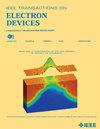磷注入具有450 ~ 1550nm光谱响应的门控MoS 2光电二极管
IF 2.9
2区 工程技术
Q2 ENGINEERING, ELECTRICAL & ELECTRONIC
引用次数: 0
摘要
高效的p型掺杂是发展MoS2电子和光电子器件的首要任务,因为MoS2具有n型半导体的特性。然而,在MoS2上植入一种cmos兼容的、可控的、区域选择性的p型掺杂工艺尚不清楚。本文报道了磷注入(P-implantation)作为CMOS工艺的一部分,通过调制注入剂量,可以选择性地实现p型掺杂,并将截止波长从~980 nm延长到1550 nm以上。通过调整注入剂量,它能够将MoS2从半导体转变为半金属。此外,我们还通过p注入制备了光谱响应范围为450 ~ 1550 nm的mos光电二极管。光电二极管的响应率是原始晶体管的24倍,特殊探测率是原始晶体管的500倍,在1550nm照明下的响应率达到6.1 A/W。综上所述,本研究为MoS2芯片的商业化开辟了指导思路,丰富了MoS2在近红外光探测中的应用场景。本文章由计算机程序翻译,如有差异,请以英文原文为准。
Gate-Controlled MoS₂ Photodiode With Spectral Response From 450 to 1550 nm by Phosphorus-Implantation
Efficient p-type doping is at the top of the priority list for developing MoS2 electronics and optoelectronics devices due to MoS2 exhibiting the characteristics of an n-type semiconductor. However, implantation, a CMOS-compatible, controllable, and area-selective p-type doping process, is still unclear on MoS2. Here, it is reported that the phosphorus-implantation (P-implantation), a part of the CMOS process, can achieve p-type doping and extend cutoff wavelength from ~980 nm to a value over 1550 nm selectively by modulating implantation dose. By tuning the implantation dose, it was able to transform MoS2 from semiconductor to semimetal. Besides, we fabricate a gate-controlled MoS2 photodiode with spectral response from 450 to 1550 nm by P-implantation. The photodiode has 24 times more responsivity and 500 times the special detectivity than pristine transistor and achieves the responsivity of 6.1 A/W at 1550-nm illumination. In summary, this study opens a guideline for commercialization of MoS2 chips and enriches the application scenarios of MoS2 in NIR photodetection.
求助全文
通过发布文献求助,成功后即可免费获取论文全文。
去求助
来源期刊

IEEE Transactions on Electron Devices
工程技术-工程:电子与电气
CiteScore
5.80
自引率
16.10%
发文量
937
审稿时长
3.8 months
期刊介绍:
IEEE Transactions on Electron Devices publishes original and significant contributions relating to the theory, modeling, design, performance and reliability of electron and ion integrated circuit devices and interconnects, involving insulators, metals, organic materials, micro-plasmas, semiconductors, quantum-effect structures, vacuum devices, and emerging materials with applications in bioelectronics, biomedical electronics, computation, communications, displays, microelectromechanics, imaging, micro-actuators, nanoelectronics, optoelectronics, photovoltaics, power ICs and micro-sensors. Tutorial and review papers on these subjects are also published and occasional special issues appear to present a collection of papers which treat particular areas in more depth and breadth.
 求助内容:
求助内容: 应助结果提醒方式:
应助结果提醒方式:


